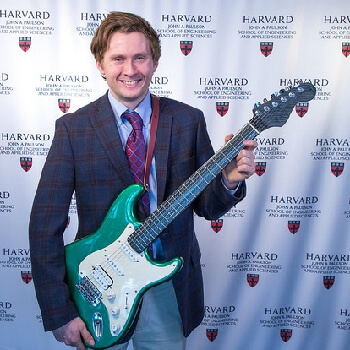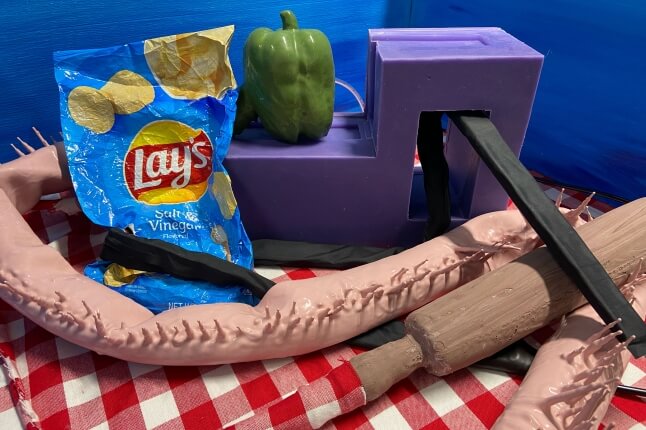News
For his senior thesis project, mechanical engineering concentrator Connor Green developed a carbon fiber guitar neck. (Photo by Eliza Grinnell/SEAS Communications)
Ranchers in rural Montana, oncology researchers, and touring rock musicians all have one thing in common—they face problems that an engineer could help solve.
Seniors in Engineering Design Projects (ES 100), the capstone course at the Harvard John A. Paulson School of Engineering and Applied Sciences (SEAS), put their problem-solving prowess to the test to develop creative solutions for these and other real-world challenges.
“Assistive Fence Building Machine”
Rico Stormer, S.B. ’18, mechanical engineering
Advisor: Rob Howe, Abbott and James Lawrence Professor of Engineering
Building fence line is essential for farmers and ranchers throughout rural North America, but the labor-intensive process is time consuming and expensive, costing between $3,000 and $5,000 per mile. Stormer, who grew up in rural Montana, retrofitted a riding lawn mower with a rack and pinion gear, pulley system, network of torsional springs, and pneumatic post driver to automatically drive fence posts into unprepared soil. The gears and pulley system move the post into place, then the pneumatic driver forces it into the ground. With the post in place, wire unfurls off a roller as the machine drives forward. His $822 system can drive a post and roll fence wire to the next post in a little more than three minutes.
“My machine could revolutionize the way fences are built today. There has been little improvement in the methods used since the Model T was invented. With my machine, I would eliminate the most physically demanding parts of fence building: driving posts and rolling out wire,” Stormer said. “After a quick financial analysis based upon system timing, I was able to determine that this machine would become economically viable at 90 seconds per post. With a few quick adjustments to the motors used, this system could easily approach that value.”
“Nonviral delivery of mRNA from mesoporous silica rods”
Kristen Rodrigues, S.B. ’18, bioengineering
Advisors: David Mooney, Robert P. Pinkas Family Professor of Bioengineering, and Maxence Dellacherie, graduate student
Rodrigues’ project was inspired by the idea that cells can be recruited to a biomaterial scaffold in vivo, where they can be reprogrammed to carry out a specific function. In cancer immunotherapy, antigen-presenting cells can be reprogrammed to travel to the lymph node and interface with the immune system to promote an antitumor response. Based on these principles, researchers are using mRNA to develop personalized cancer vaccines. Rodrigues studied methods to load mRNA onto a scaffold of silica rods, which contain microscopic pores, to promote the sustained release of mRNA over a number of days. Releasing the mRNA over time can improve the targeting of mRNA to antigen presenting cells and increase the efficiency of an antitumor vaccine.
“Without question, cancer significantly impacts many lives. For me, the application of this system in a cancer vaccine with potential for clinical translation was a significant source of inspiration,” she said. “Through this project, I learned about how engineering approaches can be applied to immunotherapy to improve cancer vaccines. Since the immune system closely interacts with tumors, the idea that it’s possible to reprogram immune cells to target tumors through vaccine approaches is really powerful.”
“Feedback Crutches”
Seif Abou Eleinen, S.B. ’18, electrical engineering
Advisor: Na Li, Assistant Professor of Electrical Engineering and Applied Mathematics
To optimally heal bone injuries, it is essential to gradually apply body weight over the course of the recovery period. While overloading can cause ligament and muscle strain or fracturing, current methods for partial weight bearing, including the use of bathroom scales or verbal instructions, are often confusing or difficult for a patient to follow. Abou Eleinen developed a dynamic feedback system within a crutch that uses load cells and accelerometers to measure a patient’s exerted weight and speed over gain cycles, comparing those measurements to patient-specified thresholds. His system, which cost about $300, measures the force exerted and the time between steps, and then provides audio feedback every 30 seconds if the user exceeds the weight threshold or is walking too fast.
“The inspiration came from when I had a major foot surgery last year and I was on crutches and a scooter for almost six months. When I first started walking, I was having trouble applying the exact weight percentage prescribed, which led to my recovery period to actually be longer,” he said. “I wanted to design a device that would help anyone who has to go through what I did.”
“Upper Limb Biomechanics Measurements using Soft Sensors”
Alisha Mah, S.B. ’18, bioengineering
Advisor: Daniel Vogt, Research Engineer at the Wyss Institute for Biologically Inspired Engineering
Motion tracking systems provide insights for rehabilitation and injury prevention, but joint measurement systems for the upper limbs often involve costly technology and heavy computational analysis. Mah used more affordable soft sensors to build a motion-tracking device that could be used to study movement in the shoulder and elbow. She used 3D printed models to fabricate the soft sensors, which are only 30mm by 20mm. Because the string sensors she used are so lightweight, they do not impede a subject’s range of motion. Using Velcro, she placed the sensors at different location on the elbow, effectively measuring extension and flexion, and then used a similar technique to measure abduction and adduction in the shoulder. While Mah’s sensors effectively measured movement, she would like to enhance the system by incorporating Bluetooth technology to enable instant feedback.
“It's pretty incredible as to what the human body can endure, and as an athlete I find joint mechanics particularly interesting,” she said. “Motion tracking is important for understanding the underlying mechanics of the human body. Soft sensing systems that track joint mechanics can help with rehabilitation and injury prevention in the clinical setting and can be used for assistive and actuation devices in the research setting.”
“Carbon fiber guitar necks”
Connor Green, S.B. ’18, mechanical engineering
Advisor: Rob Wood, Charles River Professor of Engineering and Applied Sciences
Musicians expect guitars to work consistently in a wide range of different conditions, but the wood that comprises most traditional guitar necks can be affected bychanges in temperature or humidity, often warping or swelling. Green set out to design a guitar neck from carbon fiber, a material that naturally resists moisture absorption and has a low coefficient of thermal expansion. He created a lightweight guitar neck with a core of polystyrene insulating foam, covered with a carbon fiber resin that Green shaped using a 3D printed mold. After applying a clear-coat finish and attaching the frets, Green found that his carbon fiber neck had a sustain that was a good as wooden necks, and only a slight difference in timbre that was not readily audible to listeners.
“The biggest challenges of this project involved developing procedures for all the different manufacturing steps. Some steps, such as using screws to fix the guitar neck to the body, were the same as in wooden necks. However, other steps couldn't be taken from traditional wooden neck manufacturing and it was necessary for me to devise new ways to work around the limitations of the material I was using,” he said. “Through this project, I learned that even the smallest change in a previously understood procedure can result in a more or less successful final product, and that iterating through prototypes allows you to better understand which little changes make the biggest difference.”
Cutting-edge science delivered direct to your inbox.
Join the Harvard SEAS mailing list.
Press Contact
Adam Zewe | 617-496-5878 | azewe@seas.harvard.edu



